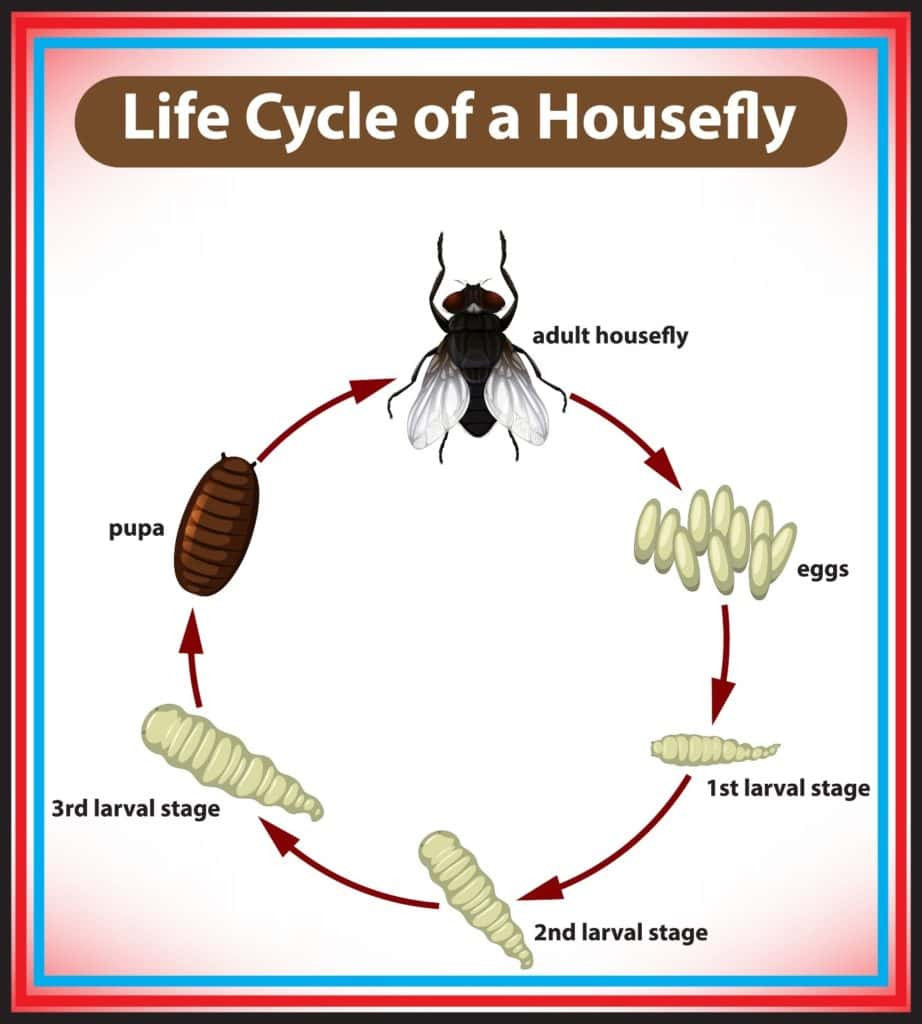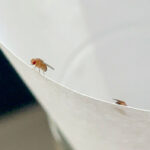Every spring and summer, many homeowners face the unwelcome buzzing of flies inside their homes. It’s a common nuisance to find these pests suddenly appearing, seemingly out of nowhere, and becoming a persistent annoyance. If you’re wondering, “Where Are The Flies Coming From In My House?”, you’re not alone. Understanding why they are there and where they originate is the first step to effectively managing them.
Flies aren’t just random visitors; they are actively seeking out environments that provide them with essential resources for survival. Your home, unfortunately, can offer just what they need: food, water, and shelter. To understand why you’re seeing flies in your house, let’s delve into their attractions and entry points.
Why Are Flies in My House?
House flies are primarily driven by basic needs – sustenance and a suitable environment. Inside your home, they can find a variety of attractants:
-
Food Sources: Flies have a keen sense of smell and are attracted to a wide array of food sources, many of which are commonly found in homes. This includes:
- Garbage: Kitchen trash cans, especially those containing food scraps, are a major draw for flies. The decaying organic matter provides both food and breeding grounds.
- Spills and Crumbs: Even small spills of sugary drinks, food crumbs on counters or floors, and unwashed dishes can attract flies.
- Pet Food: Leftover pet food, whether dry or wet, is another appealing food source.
- Fruits and Vegetables: Overripe or rotting fruits and vegetables left on countertops or in fruit bowls are highly attractive.
- Sweet Substances: Flies are particularly fond of sweet substances. Soda spills, sugary syrups, and even sugary residues can draw them in.
-
Warmth and Shelter: Flies are cold-blooded insects and seek warmth, especially during cooler periods. Your house provides a stable and warmer environment compared to the outdoors, particularly attractive during spring and fall when temperatures fluctuate. In the heat of summer, they might also seek shelter indoors to escape extreme temperatures.
-
Moisture: Flies need water to survive, and sources of moisture in your home can be attractive. This can include leaky pipes, damp areas in basements or bathrooms, and even condensation around windows.
 Housefly Life Cycle
Housefly Life Cycle
How Do Flies Get Into Your House?
Once attracted to your home’s vicinity, flies can find multiple ways to enter. Common entry points include:
-
Open Doors and Windows: The most straightforward entry is through unscreened or open doors and windows. Flies are opportunistic and will readily fly in, especially if they detect enticing scents from inside.
-
Damaged Screens: Even with screens, small tears or holes in window or door screens provide easy access for flies to slip through. Regularly check and repair any damage to your screens.
-
Cracks and Gaps: Flies are surprisingly small and can exploit even tiny cracks and gaps in your home’s structure. Check around doors and windows frames, vents, utility entrances, and pipes for any openings that need sealing.
-
Plumbing Systems and Drains: Drain flies, in particular, breed in the moist organic matter that accumulates in drains. They can emerge from drains in sinks, showers, and floor drains.
-
Following Scents: Flies are adept at following air currents and scents. If you have strong odors emanating from your home, such as from garbage, pet food, or outdoor cooking, flies can follow these scents indoors.
What are Houseflies? Identifying the Culprits
It’s helpful to know what house flies look like to properly identify them and differentiate them from other fly species. The common housefly (Musca domestica) is typically:
- Color: Dark gray.
- Size: Between 1/8” to 1/4” long.
- Body Structure: They have six legs, antennae, a small oval body, and two wings that overlap on their back. Their larvae are maggots, which are creamy white-gray and rice-like in appearance, often found in decaying organic matter.
Houseflies are prevalent throughout the United States and are known for their unsanitary habits.
The Problem with House Flies: Disease and Filth
House flies are more than just a nuisance; they pose health risks due to their feeding and breeding habits.
-
Disease Vectors: House flies feed on decaying matter, garbage, feces, and other filthy substances. In the process, they pick up a wide range of pathogens, including bacteria, viruses, and parasites. They can carry over 100 different pathogens.
-
Contamination: When house flies land on food preparation surfaces, utensils, or directly on food, they can transfer these pathogens. They also regurgitate and defecate frequently, further contaminating surfaces and food. Diseases they can transmit include salmonella, E. coli, typhoid fever, and various diarrheal diseases.
-
Unsanitary Feeding Habits: Flies liquefy their food by regurgitating digestive juices onto it and then sucking it up. This process, combined with their frequent defecation, makes them highly unsanitary pests to have around food and in your home.
House Flies vs. Cluster Flies: Are They Different?
Sometimes, people confuse house flies with cluster flies, as they can look similar. However, there are key differences:
-
Cluster Flies: Larger than house flies, about 8-10 mm in length compared to the house fly’s 6-7 mm. They are also clumsier fliers and often found clustering together, especially around windows in the fall and winter.
-
Diet and Disease: Unlike house flies, cluster flies do not breed in garbage or feces and are not known to transmit diseases. They are considered less of a health risk as they feed on plant nectar, sap, and other less contaminated substances. Cluster flies are more of a nuisance due to their sheer numbers when they congregate in homes for overwintering.
-
Origin of Cluster Flies: Cluster flies lay their eggs in soil, and their larvae parasitize earthworms. Adult cluster flies enter homes in the fall to find sheltered places to spend the winter.
While cluster flies are less of a health concern, both types can be unwanted in your home. Focusing on house fly control is crucial due to their disease-spreading potential.
Effective Control Measures for House Flies
Getting rid of house flies and preventing future infestations involves a multi-pronged approach:
1. Maintaining a Clean Home Environment
Cleanliness is the cornerstone of fly control. By eliminating food sources and breeding sites, you can significantly reduce fly populations.
- Frequent Trash Disposal: Empty kitchen trash cans daily, especially if they contain food waste.
- Clean Trash Cans: Regularly clean and sanitize both indoor and outdoor trash cans to remove food residues and odors that attract flies.
- Cover Food and Drinks: Store food in airtight containers and cover drinks to prevent flies from accessing them.
- Clean Spills and Crumbs Immediately: Wipe up any spills and crumbs on countertops, tables, and floors promptly.
- Wash Dishes Promptly: Do not leave dirty dishes sitting out. Wash them or load them into the dishwasher as soon as possible.
- Secure Outdoor Trash: Ensure outdoor trash cans have tight-fitting lids to prevent flies from breeding in them.
- Repair Screens and Seals: Fix any torn screens, and seal cracks and gaps around windows, doors, and utility entrances to block fly entry.
- Rinse Recyclables: Rinse out bottles and cans before placing them in recycling bins to remove sugary or food residues.
- Pet Waste Management: Clean up pet waste in your yard promptly, as it can attract flies.
- Yard Cleanliness: Remove any decaying organic matter from your yard, such as fallen fruit or rotting vegetation.
- Clean Grill Regularly: Scrub your outdoor grill to remove food debris and grease buildup that can attract flies.
2. Utilizing Biological Controls
Introducing natural predators can help manage fly populations in and around your home.
-
Spiders and Wasps: Spiders and certain wasps are natural predators of flies. While you might not want an abundance of spiders indoors, tolerating some spiders and wasps outdoors can contribute to natural fly control. Parasitic wasps, in particular, are effective at controlling fly populations and are generally not aggressive towards humans.
-
Predatory Plants: Venus flytraps and other carnivorous plants can capture and consume flies. While they won’t eliminate a major infestation, they can be a helpful supplementary control method.
3. Seeking Professional Pest Control
For severe or persistent fly infestations, professional pest control services are often the most effective solution.
- Expert Identification and Treatment: Pest control professionals can accurately identify the type of fly and locate breeding sites that may be hidden, such as in wall voids or drains.
- Targeted Treatments: They can apply targeted treatments, including environmentally responsible pesticides if necessary, to eliminate fly infestations and prevent recurrence.
- Drain Treatments: For drain flies, professionals can use specific drain treatments to eliminate breeding sites within plumbing systems.
- Long-Term Solutions: Pest control companies can also provide advice and implement long-term strategies to prevent future fly problems.
Warning: If using pesticides, always follow label instructions carefully and prioritize safety precautions. Store pesticides out of reach of children and pets.
If you’re struggling with a persistent fly problem and wondering “where are the flies coming from in my house?”, implementing these control measures and considering professional help can provide effective solutions to keep your home fly-free. For comprehensive pest management, especially if you suspect a larger infestation or need help with fly identification and targeted treatments, contacting a local pest control service is a wise step.
next post >

